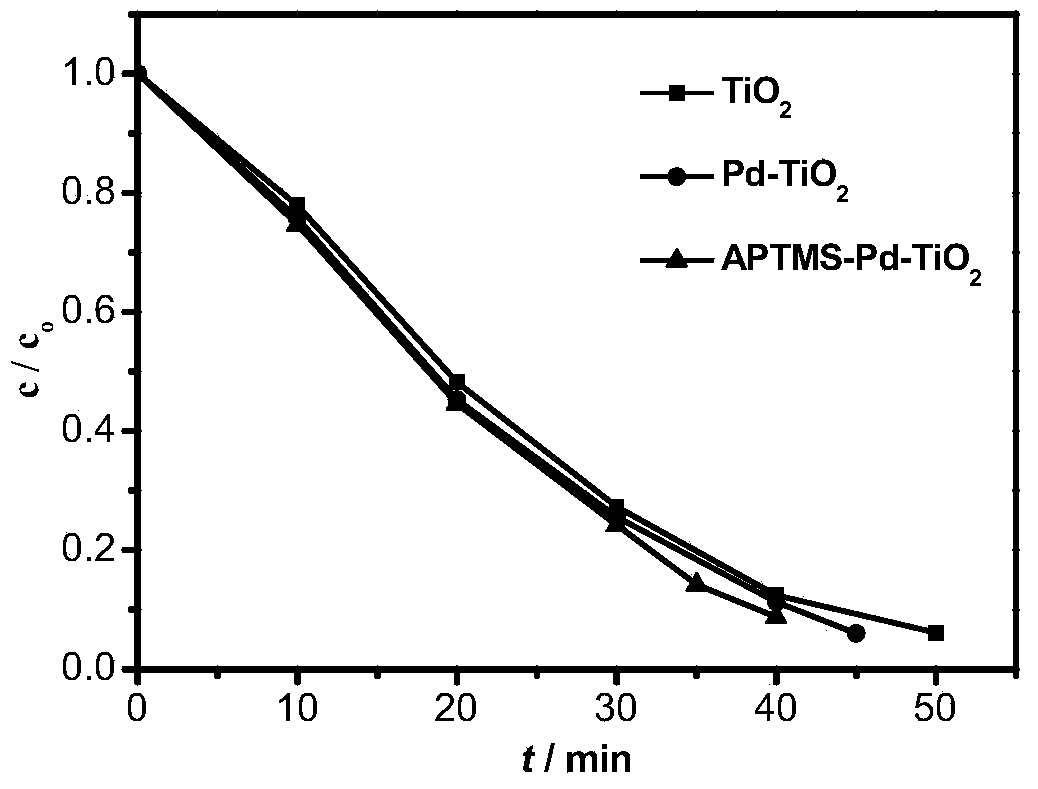Preparation method of amino-modified Pd/TiO2 photocatalyst
A technology of photocatalyst and amino modification, applied in physical/chemical process catalysts, chemical instruments and methods, metal/metal oxide/metal hydroxide catalysts, etc., can solve the problems of low degradation efficiency, achieve improved dispersion, Improve the effect of degradation and improve the photon quantum efficiency
- Summary
- Abstract
- Description
- Claims
- Application Information
AI Technical Summary
Problems solved by technology
Method used
Image
Examples
Embodiment 1
[0020] A kind of Pd / TiO with amino modification 2 The preparation method of photocatalyst specifically comprises the steps:
[0021] (1) Synthesis of TiO with {001} high-energy crystal plane 2 Nanosheets
[0022]Put 10ml of tetrabutyl titanate and 0.8ml of hydrofluoric acid aqueous solution with a concentration of 47% by volume in a polytetrafluoroethylene-lined autoclave, and conduct a hydrothermal reaction at 180°C for 24 hours. , 0.1M NaOH and deionized water for 3 times each, then placed in a vacuum drying oven at a controlled temperature of 80°C for 12 hours, then removed and ground, then placed in a muffle furnace for calcination at a controlled temperature of 400°C for 2 hours, and finally passed 200 mesh sieve, that is to get TiO with {001} high-energy crystal plane 2 Nanosheets;
[0023] (2) APTMS modified TiO with {001} high-energy crystal plane 2 Nanosheets
[0024] Add 0.05ml-2ml of APTMS to 100ml of water, then add 150mg of TiO with {001} high-energy crystal...
Embodiment 2
[0035] A kind of Pd / TiO with amino modification 2 Preparation method of photocatalyst, including synthesis of TiO with {001} high-energy crystal faces 2 Nanosheets, APTMS Modification of TiO with {001} High Energy Crystal Plane 2 Nanosheets and Preparation of Pd / TiO 2 Photocatalyst three steps;
[0036] (1) Synthesis of TiO with {001} high-energy crystal plane 2 Nanosheets
[0037] Tetrabutyl titanate and hydrofluoric acid aqueous solution with volume percent concentration of 47% were placed in a polytetrafluoroethylene-lined autoclave, and the volume ratio of tetrabutyl titanate to hydrofluoric acid aqueous solution was 10:0.8, controlled The temperature was 180°C for hydrothermal reaction for 24 hours. After the reaction solution was washed with ethanol, 0.1M NaOH and deionized water in sequence, the obtained sample was vacuum-dried at 80°C, ground after drying, and then put into a muffle furnace for calcination at a controlled temperature of 400°C. 2h, through a 200-me...
Embodiment 3
[0043] A kind of Pd / TiO with amino modification 2 Preparation method of photocatalyst, including synthesis of TiO with {001} high-energy crystal faces 2 Nanosheets, APTMS Modification of TiO with {001} High Energy Crystal Plane 2 Nanosheets and Preparation of Pd / TiO 2 Photocatalyst three steps;
[0044] (1) Synthesis of TiO with {001} high-energy crystal plane 2 Nanosheets
[0045] Tetrabutyl titanate and hydrofluoric acid aqueous solution with volume percent concentration of 47% were placed in a polytetrafluoroethylene-lined autoclave, and the volume ratio of tetrabutyl titanate to hydrofluoric acid aqueous solution was 10:0.8, controlled The temperature was 180°C for hydrothermal reaction for 24 hours. After the reaction solution was washed with ethanol, 0.1M NaOH and deionized water in sequence, the obtained sample was vacuum-dried at 80°C, ground after drying, and then put into a muffle furnace for calcination at a controlled temperature of 400°C. 2h, through a 200-me...
PUM
 Login to View More
Login to View More Abstract
Description
Claims
Application Information
 Login to View More
Login to View More - R&D
- Intellectual Property
- Life Sciences
- Materials
- Tech Scout
- Unparalleled Data Quality
- Higher Quality Content
- 60% Fewer Hallucinations
Browse by: Latest US Patents, China's latest patents, Technical Efficacy Thesaurus, Application Domain, Technology Topic, Popular Technical Reports.
© 2025 PatSnap. All rights reserved.Legal|Privacy policy|Modern Slavery Act Transparency Statement|Sitemap|About US| Contact US: help@patsnap.com

